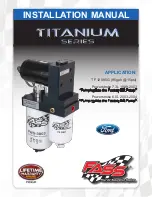
R
be more prone to damage from road
hazards
R
adversely affect ride comfort
R
increase stopping distance
Checking tire inflation pressure
Follow recommended tire inflation pressures.
Do not underinflate tires. Underinflated tires
wear excessively and/or unevenly, adversely
affect handling and fuel economy, and are
more likely to fail from being overheated.
Do not overinflate tires. Overinflated tires can
adversely affect handling and ride comfort,
wear unevenly, increase stopping distance,
and result in sudden deflation (blowout)
because they are more likely to become
punctured or damaged by road debris,
potholes etc.
Do not overload the tires by exceeding the
specified load limit as indicated on the Tire
and Loading Information placard on the
driver’s door B-pillar. Overloading the tires
can overheat them, possibly causing a
blowout. Overloading the tires can also result
in handling or steering problems, or brake
failure.
Check the tire inflation pressure at least once
a month.
Check and adjust the tire inflation pressure
when the tires are cold (
Checking tire inflation pressure
Follow the steps below to achieve correct tire
inflation pressure:
X
Remove the cap from the valve on one tire.
X
Firmly press a tire gauge onto the valve.
X
Read the tire inflation pressure on the tire
gauge and check against the
recommended tire inflation pressure on the
Tire and Loading Information placard on the
driver’s door B-pillar (
necessary, add air to achieve the
recommended tire inflation pressure.
X
If you have overfilled the tire, release tire
inflation pressure by pushing the metal
stem of the valve with e.g. a tip of a pen.
Then recheck the tire inflation pressure
with the tire gauge.
X
Install the valve cap.
X
Repeat this procedure for each tire.
Advanced Tire Pressure Monitoring
Your vehicle is equipped with the Advanced
Tire Pressure Monitoring System (Advanced
TPMS). It measures the tire inflation pressure
in the vehicle’s tires and issues warnings in
case of pressure loss in one or more of the
tires.
The TPMS is equipped with a combination low
tire pressure/ TPMS malfunction telltale in
the instrument cluster. Depending on how the
telltale illuminates, it indicates a low tire
pressure condition or a malfunction in the
TPMS system itself:
R
If the telltale illuminates continuously, one
or more of your tires is significantly
underinflated. There is no malfunction in
the TPMS.
R
If the telltale flashes for 60 seconds and
then stays illuminated, the TPMS system
itself is not operating properly.
The TPMS only functions on wheels that are
equipped with the proper electronic sensors.
The TPMS does not indicate a warning for
wrongly selected inflation pressures. Always
adjust tire inflation pressure according to the
Tire and Loading Information placard or the
supplemental tire inflation pressure
information on the inside of the fuel filler flap.
284
Tires and wheels
Operation
245_AKB; 1; 73, en-US
d2ureepe,
Version: 2.11.8.1
2009-09-03T15:03:17+02:00 - Seite 284
Summary of Contents for B-Class F-CELL
Page 4: ...245_AKB 1 73 en US d2ureepe Version 2 11 8 1 2009 09 03T15 03 17 02 00 Seite 2 ...
Page 32: ...30 245_AKB 1 73 en US d2ureepe Version 2 11 8 1 2009 09 03T15 03 17 02 00 Seite 30 ...
Page 210: ...208 245_AKB 1 73 en US d2ureepe Version 2 11 8 1 2009 09 03T15 03 17 02 00 Seite 208 ...
Page 316: ...314 245_AKB 1 73 en US d2ureepe Version 2 11 8 1 2009 09 03T15 03 17 02 00 Seite 314 ...
Page 358: ...356 245_AKB 1 73 en US d2ureepe Version 2 11 8 1 2009 09 03T15 03 17 02 00 Seite 356 ...
















































